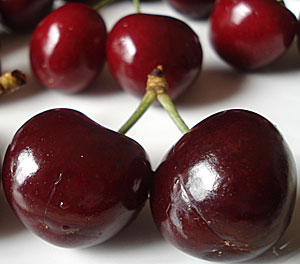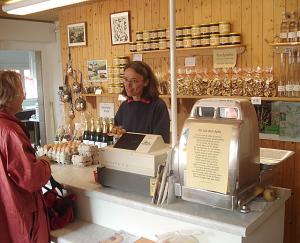
At the moment, cherries are everywhere here in Switzerland. Roadside signs proclaim "Kirschen" or "Chriesli" (the Swiss-German dialect for cherries), luring you to farms and fruit groves and farm stores. They're on sale at the Migros supermarket too, for the busy person to pick up in a hurry.
When I get started on cherries, I can't seem to stop until I've had my fill, and I do mean fill, of that sweet, dark juice with a hint of sourness. Fresh cherries are so good that I just can't bring myself to do anything more than pop them in my mouth one after another, methodically spitting out the pits. I know there are numerous cherry recipes out there, but as delicious as things like cherry pie and cherry clafouti are, there's really nothing to beat the naked, unadorned cherry.
Filed under:
fruit vegetables produce
 The sign that is no more.
The sign that is no more.
As we approached the tiny hilltop village of Montsegur-sur-Lauzon in northern Provence, my mouth was already watering in anticipation of the bread at the one and only boulangerie (bakery) there. I'd been looking forward to this for months, ever since last November, when we'd made one last stopover to load up on bread to sustain us for the long drive back home and a couple of days beyond.
I've written about my love for this boulangerie before. The bread there was the best I've ever had - bursting with flavor and character. Even when the loaves turned a bit stale after a couple of days, they were still so good. I was convinced that if the baker, Monsieur Metaud, was in Paris, he'd be world famous.
It was a Sunday, and there was a small queue of people waiting for their bread in the tiny store. Neither of the two people behind the counter, a young man and a middle aged woman, were Madame or Monsieur Metaud, but that didn't concern us - they had other people selling bread there before, especially on weekends. But as we shuffled closer to the front of the line, something seemed a bit off. The collection of exotic teas that used to line the wall shelves were gone. The pretty display of confections was quite pared down.
Filed under:
bread essays food travel provence france

One of the (many) food obsessions I have is nut brittles. Peanut brittle, macademia nut brittle, almond brittle (which, when pulverized, turns into praline). I love that combination of caramel and nut flavor. Peanut brittle is the most handy kind to get a hold of, and make. I make it as often as my teeth and waistline allow.
But, I realized yesterday that I have never had truly good peanut brittle.
Filed under:
snack sweet shopping favorites

BBC Four is running a series of program(me)s about the Edwardians, and two of those are about the food of the era. They have already aired but will be repeated several times as most BBC Four shows are. Both are well worth watching for anyone interested in food and history.
Edwardian Supersize Me is the showier of the two. Giles Coren, food critic for The Times, and TV presenter Sue Perkins lived the life of well-off Edwardians for a week, and ate like the Edwardians of the upper-middle class did - in Sue's case while wearing a corset. Their in-house meals were cooked by famed food writer Sophie Grigson, from an Edwardian housekeeping book, and they also ate out frequently since this was the era when restaurant dining became popular in England.
Filed under:
books and media tv bbc uk

Back in February I reported on the new limited edition Guinness Marmite. Since then, the salty yeast spread connoisseur in me yearned to taste this mysterious combination. Parts of me panicked at the thought of it selling out before I had a chance at it.
Enter my friend Mimi to the rescue. She kindly procured not one, but four, yes 4, 250 gram jars of Guinness Marmite for me, which arrived in the mail today. My first reaction: "ZOMG, a kilo of Marmite!" (That's about 2.2 lb for the metrically challenged.)
Calming down, I proceeded to inspect it in detail.
Filed under:
ingredients offbeat uk marmite

Whenever I am feeling blue, one of the foods that I crave is onigiri. You could just chalk that up to the fact that it's mostly rice = carbs and I'm just craving a carb fix. But it really goes beyond that. It's tied to memories of my aunts making row upon row of perfectly shaped onigiri for a family gathering, and the salty tinge on my lips from the giant onigiri my mother made for me for a school outing.
Two of the most popular articles here on Just Hungry are the ones about onigiri. It's great to see so many people from around the world enjoying this quintessential Japanese comfort food.
There are two very interesting Japanese movies where onigiri play a starring role, in quite different ways; Kamome Diner (Kamome Shokudoh) and Supermarket Woman (Suupaa no Onna). Although neither seems to be available on DVD in English speaking countries yet, I thought I'd talk about them a bit.
Filed under:
books and media japanese onigiri memories movies
In Japan, tsukemono or pickles are used as hashi-yasume, literally "chopstick resters", side dishes that have a totally different texture and flavor. So for instance if you had some grilled meat with a sweet-savory sauce as the main course, you might have some simple, crunchy pickled cucumber slices to go with it.
This week I'll be posting some quick Japanese vegetable pickle recipes. Japanese pickles can be very loosely divided into three kinds: the kind that take some time to 'ripen', but then last indefinitely, rather like Western style pickles; the kind that is ready in a few days, but which require a pickling bed that takes time to make and to maintain; and finally, the quick and easy kind that can be made and eaten within a day. The last two kinds do not keep well - just like fresh vegetables, they must be eaten within a short time.
Quick pickles, called sokusekizuke (instant pickles) or ichiya-zuke (overnight pickles) depending on how long they take to come to full flavor, are very easy to make as their names suggest. They are a great way to prepare vegetables without having to add any additional fat, though a few recipes do call for some oil.
Filed under:
japanese lighter preserves and pickles vegetables vegan salad tsukemono

For Food Destinations No. 5, the theme of which is "Where Everybody Knows Your Name", our first inclination was to pick a restaurant we go to often. But while we have some favorites, we don't really go to any one restaurant more than once or twice a month on average, since we like variety when eating out. On the other hand, there are a couple of food stores that we shop in almost every day, where they truly know our names. One of our favorite haunts is our very typically Swiss local farm shop in the suburbs of Zürich.
Filed under:
food destinations food events food travel shopping switzerland
Submitted by maki on 14 March, 2007 - 14:51

I am finally getting around to sowing some seeds for the vegetable garden. I really should have sown some things earlier, but I figure it's not too late yet.
If you are planning a vegetable garden, or even a few pots on your windowsill, and want to introduce some Japanese flavors, here's a list of some herbs and vegetables to consider growing, in order of importance and ease of growing in a temperate climate. (That's one with real winters...at least, before global warming.) The ones marked with an *asterisk can be grown in pots. A couple of my favorite seed sources are listed at the bottom.
Type:
feature Filed under:
japanese vegetables shopping gardening herbs

When I wrote about essential Japanese cooking equipment a while back, I forgot to mention one item that I use quite often, a suribachi. A suribachi is a sturdy ceramic bowl that's used with a grinding stick called a surikogi like a mortar and pestle. While I'm a big fan of handy electric equipment like food processors for many tasks, sometimes the results you get by doing things by hand are well worth the elbow grease needed.
Filed under:
equipment japanese
Pages